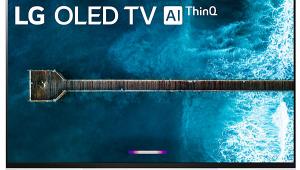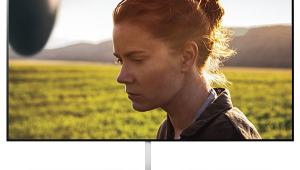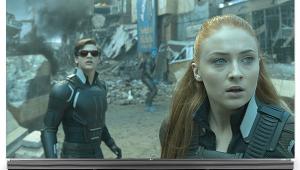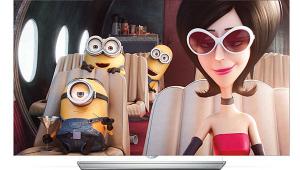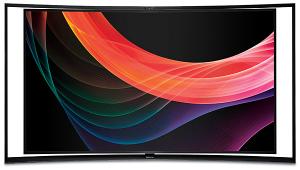So why does the curved screen cause distortion here but not at movie theaters? This is probably the second or third review I've heard say that so I'm inclined to believe it but aren't movie screens curved? Why is this a negative in a TV?
Samsung KN55S9C 3D OLED HDTV Observant OLED Observations
Geoffrey Morrison, Contributing Technical Editor
I had gotten to the point that I’d nearly given up hope I’d ever see a real OLED television. I just saw a real OLED television! The promises of epic contrast ratio and incredible black levels are fully realized. Set to full-throttle brightness, in a dark room, it’s almost too bright. Al and Rob kept turning down the Cell Light brightness limiter, while I kept nagging them to turn it up (, man). When displaying a full-screen black image, everything else in your room is brighter than the TV. The depth and realism to the image is incredible.
It isn’t, of course, perfect. For one, it’s curved. While the curved screen certainly makes it stand out from other flat TVs, the negatives outweigh any claimed positives. Unless you’re sitting eye-level with the center of the screen, it bows oddly. The idea of a curved screen is so each part of the image is equidistant from your eyes, but to be at the center of the radius implied by the curve, you’d be so far away, the TV might as well be a postage stamp.
But none of that matters. The technology is here, and we’ll almost certainly see flat models soon, hopefully along with larger and cheaper versions too. OLED may not be your next TV, but once you see it, you’ll want it to be. Someday, hopefully, it will be.
Rob Sabin, Editor-in-Chief
Let’s put aside for a moment the sheer giddy delight of being locked in a room with this set and a $50,000 battery of test gear for six hours. (You can see a few pictures and experience some of it for yourself at twitter.com/RobFSabin.) When I finally got my composure and applied full critical faculties, it quickly became clear that this wasn’t the perfect television it could have been. Let’s start with the curved screen. While it’s a clever marketing ploy, it’s ridiculous at this size, and at the appropriate 8-foot viewing distance for a 55-inch TV, it lends a noticeable geometric bowing to the top and bottom of the image. This flattens out at twice that distance, but that makes the image look tiny.
Then there’s that odd and somewhat erratic pink clouding of the image that was evident on white backgrounds. It’s subtle and not obnoxiously distracting, but it’s noticeable on the right scenes once you know it’s there. Viewed close up (say, 4 feet away), it definitely shifted in color and intensity as I moved on and off axis, though it’s not apparent to me that the self-emanating pixels found in an OLED display should exhibit such non-uniform behavior. So I’ll have to agree with Al that until we get to see a perfectly flat OLED TV, the screen curvature and filtering is suspect here. Bottom line: Unless we find this to be an inherent limitation of the technology, it shouldn’t be there in a $9,000 HDTV when a $1,500 plasma of the same size delivers perfectly uniform light and color output. And while we’re on that topic, there’s that price: Even if $9,000 looks like a fire sale next to LG’s competitive $15,000 entry, it’s an awful lot of ka-ching for what you get.
On the other hand, what you get is essentially endless and infinite contrast—deep blacks, bright highlights, and a near-breathtaking vividness that even an unschooled eye should spot in an instant. Contrast is by far the most important attribute of display image quality, which is why we run on ad nauseam about black levels in our test reports. With OLED, the rapid switching of the pixels takes the blacks all the way to zero while delivering the kind of peak brightness that could burn a hole through your skull and leave a Joker-like grin permanently etched on your face. This Samsung and LG’s set may turn out to be slightly flawed first-generation offspring, but it turns out they really do represent the Holy Grail of display technologies. OLED is finally here, and much to my shock (and awe), it’s everything they always promised us.
- Log in or register to post comments


I think the distortion is due to the size of the screen. A movie theater screen is MUCH bigger than 55 inches.


Samsung, save the misguided curved panel, bring down the price, get rid of the outboard box- this is not a positive. Bag the non-ergonomic remote and did I mention- drop the price, then you might sell a couple of these over-engineered Frankensteins.

...that the outboard input management, and possibly image processing, seems to be a best practice for displays. It is an excellent idea on a panel that should outlast multiple connectivity evolutions. The curve, though, is strange. Could it be a work around for some little known design challenge or inherent flaw for OLED panels of this size?



